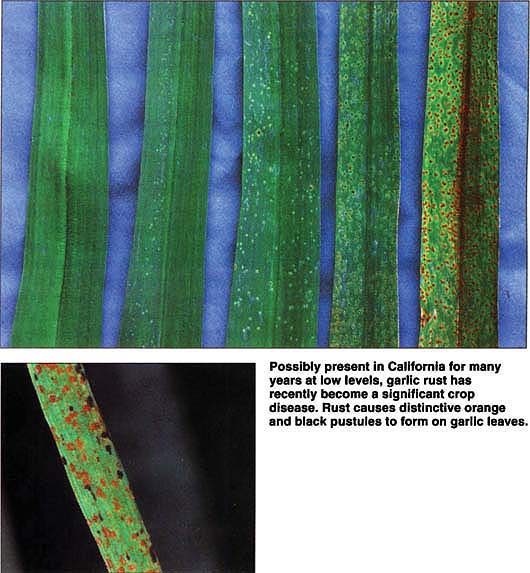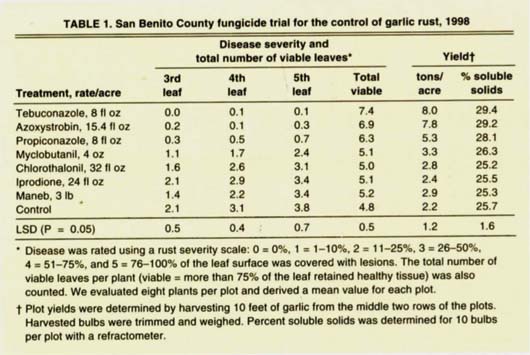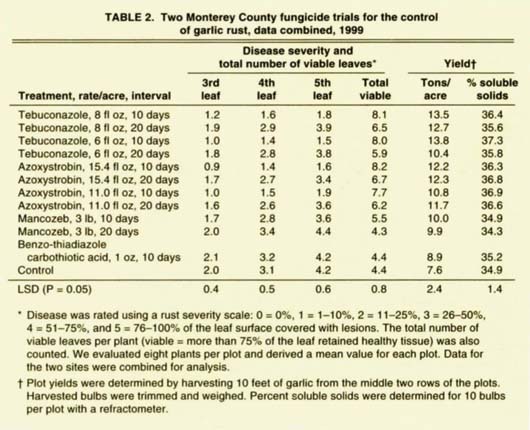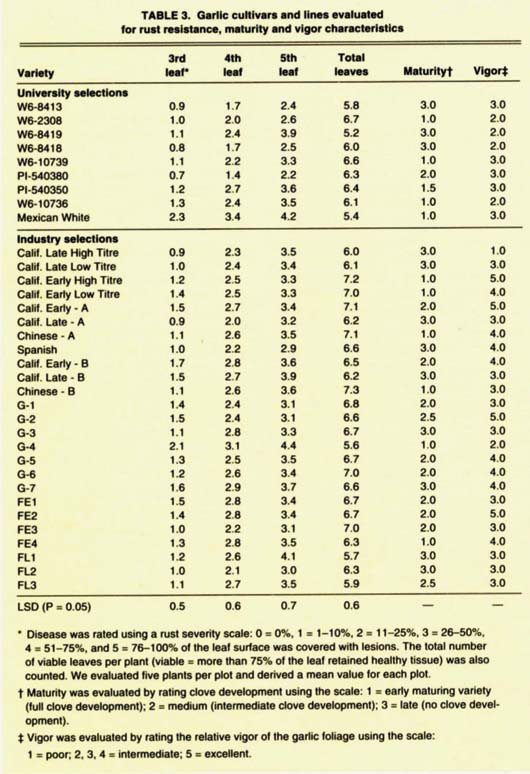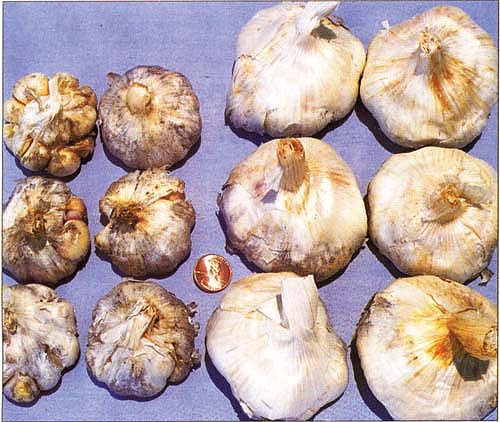All Issues
Rust disease continues to threaten California garlic crop
Publication Information
California Agriculture 55(5):35-39. https://doi.org/10.3733/ca.v055n05p35
Published September 01, 2001
PDF | Citation | Permissions
Abstract
In 1998, following the very wet EI Niño weather event, a devastating outbreak of rust disease severely damaged the garlic crop in California. The disease also occurred in 1999 and 2000, indicating that rust may have developed into an annual problem. We identified the pathogen as Puccinia allii. In our study, it infected allium crops such as garlic, onion and chives, but not leek, elephant garlic or shallot. Currently registered materials did not control the disease, but tebuconazole (Folicur) and azoxystrobin (Quadris) provided good protection against garlic rust. Based on our work, a Section 18 emergency exomption for tebuconazole was approved by state pesticide regulators. We tested 34 UC and industry garlic varieties and found that none were completely resistant to garlic rust.
Full text
Approximately 84% of the commercial garlic grown in the United States is produced in California. Of the total 37,100 acres grown here, about 60% to 65% is grown for dehydrated products, while the rest is sold fresh (CASS 2000). California garlic can be grouped into early (planted early to late October) and late (planted late October to early December) crops that are harvested in mid-June to early July and late July, respectively. The majority of the state's garlic is grown in the inland San Joaquin Valley (Fresno and Kern counties) and the coastal Salinas Valley (Monterey County).
In 1998, a devastating outbreak of rust disease affected garlic throughout California. During this year, El Niño weather conditions, with record-high rainfall and long periods of cool temperatures, favored the development of rust. The disease was widespread and severe in both growing regions. It was first observed in early spring (February and March); later on (May and June), 100% of the plants were infected in many fields. An estimated 54% (20,015 acres) of California garlic acreage was affected. Average yields dropped from 9.50 tons per acre to 4.74 tons per acre, a 50% reduction in expected yields. The 1998 average gross value per acre was $3,214, or 73% of normal; bulb weights were 25% to 60% of normal. In addition, the quality of the crop was severely affected; soluble solids were reduced 15%, and diseased bulbs lacked the protective dry outer skins. This caused the garlic to shatter when it was harvested mechanically, resulting in loose cloves that were left in the fields. Growers were forced to use hand labor to retrieve the bulbs, and harvest costs were three to five times higher than usual.
Possibly present in California for many years at low levels, garlic rust has recently become a significant crop disease. Rust causes distinctive orange and black pustules to form on garlic leaves.
The earliest symptom of rust disease is small (less than one-eighth inch), circular to elongate white flecks that occur on both sides of leaves. As the disease progresses, these small spots expand, and the leaf tissue covering the lesions ruptures. Masses of the characteristic orange, powdery spores (urediniospores) of a rust fungus then become visible as pustules. Severely infected leaves are almost entirely covered with pustules, resulting in extensive yellowing, wilting and drying of leaves. Teliospores, a second type of spore formed by many rust species, later develop on the same leaves, resulting in black pustules. The severity of the rust was so extreme in 1998 that entire fields turned prematurely yellow and then brown.
While rust on garlic was reported in California as early as 1934 (Gardner 1940), the disease has never been economically important. The 1998 rust outbreak was an unprecedented and damaging event for California agriculture. The purpose of this multiyear study was to characterize the rust pathogen and find means of managing the disease.
Identifying the rust species
Because bulbous crops in the genus Allium can be infected by several different rust pathogens, we collected samples of diseased garlic and onion from various locations in 1998 and 1999 to identify the rust species. Dozens of samples of garlic were collected from Monterey, San Benito and Kern counties. During the course of this study, rust occurred sporadically and at low severity on onion; hence, only one sample was collected from onion (Monterey County). For each sample, we microscopically examined the urediniospores and teliospores and compared them with previously published descriptions of various garlic rust fungi.
Rust samples from all locations and years were similar. While the orange urediniospores can be used to identify rust species, the dark teliospore stage is usually more distinctive. Teliospores on garlic leaves were two-celled and borne on fragile, short stalks. The teliospores developed inside leaf pustules that were divided up into cavities or compartments due to the presence of fused fungal structures called paraphyses. Based on the characteristics of the urediniospores, teliospores and paraphyses, we confirmed that the pathogen currently causing rust in California is Puccinia allii and fully characterized California isolates for the first time (Jennings et al. 1990; Laundon and Waterston 1965).
Infection on allium crops
To determine the allium host range of the California garlic rust pathogen, we collected isolates from three locations (Soledad, King City and Hollister) for use in inoculation experiments. For each isolate, we prepared spore suspensions and then sprayed them onto potted, 2-month-old plants of several cultivars of the following allium plants: garlic, onion, chives, leek, elephant garlic and shallot. Immediately after inoculating them, we placed the plants in a dew chamber for 48 hours, then grew them in a green-house. We examined plants weekly for signs of rust disease. This inoculation experiment was repeated once.
Light to moderate rust developed on all inoculated garlic plants after 4 to 5 weeks. All four onion cultivars were susceptible to the P. allii isolates from garlic. However, disease severity on onion was consistently lower than on garlic. Chives were susceptible, while shallots developed a very small amount of rust. Leek and elephant garlic failed to develop any rust. There were no significant differences in disease severity between the Soledad, King City and Hollister rust isolates, and results from the two experiments were similar (Koike et al. 2001).
Evaluating fungicides
We conducted field evaluations of fungicides to control rust in commercial and experimental fields in 1998,1999 and 2000, in Monterey, San Benito and Kern counties. For most trials, we used experimental designs of completely randomized blocks with four replications. Plots generally measured 20 feet long by two beds wide and contained two garlic seed rows per bed. We added a nonionic surfactant to the sprays and applied treatments with a carbon dioxide backpack sprayer.
The 1998 outbreak of garlic rust, facilitated by the El Niño weather system, caused entire fields to turn brown. Yields are significantly reduced and mechanical harvesting becomes difficult.
The initial field trials (San Benito and Kern counties) tested a wide range of fungicides and included: untreated control, propiconazole (Tilt 3.6E), myclobutanil (Rally 40W), azoxystrobin (Quadris 2.08SC), chlorothalonil (Bravo 720, Bravo Weather Stik 6F), iprodione (Rovral 4F), tebuconazole (Folicur 3.6F), maneb (Maneb 75 DF, Manex), metalaxyl/mancozeb (Ridomil MZ), sulfur (Thiolux) and copper hydroxide (Kocide DF). Most fungicide treatments consisted of four applications made at 7- to 10-day intervals.
We designed two subsequent trials in Monterey County, based on the results generated by the initial trials. We focused on the two best-performing fungicides, tebuconazole and azoxystrobin, sprayed at two rates and at 10-or 20-day intervals. Other treatments included untreated control, mancozeb (Manzate 200) and benzo-thiadiazole carbothioic acid (Actigard).
For the San Benito and Monterey county experiments, we evaluated rust near crop maturity by assessing disease on the third, fourth and fifth youngest leaves. We estimated disease severity using a scale in which 0 signified that 0% of the leaf surface was covered with pustules, 1 meant 1% to 10% was covered, 2 meant 11% to 25%, 3 meant 26% to 50%, 4 meant 51% to 75%, and 5 meant 76% to 100%. As an additional measurement of rust impact, we counted the total number of viable leaves per plant (viable meaning that more than 75% of the leaf retained healthy tissue). We evaluated eight plants per plot and derived a mean value for each plot. We determined plot yields by harvesting garlic from a 10-foot length in the middle two rows of each plot. We trimmed harvested bulbs according to standard commercial practice and weighed them. We determined percent soluble solids (a measure of sugars in the cloves) for 20 bulbs per plot with a refractometer.
For the Kern County experiment, we assessed treatment effects on plants in a 3-foot length from the center bed of each plot. Because of the severe disease that occurred at this location, only the youngest leaves could be evaluated. We randomly sampled 15 of the youngest leaves per plot and rated them for percent leaf surface covered with lesions. We harvested garlic bulbs from a 3-foot length in the center bed of each plot and trimmed and weighed them. We then calculated mean bulb weight.
In the initial trials (San Benito and Kern counties), tebuconazole and azoxystrobin provided the best control of garlic rust disease because they resulted in the lowest disease severity ratings and highest number of viable leaves. Most of the other materials gave rust control that was significantly less effective (table 1). Likewise, tebuconazole and azoxystrobin treatments resulted in the highest yields and percent soluble solid readings (Koike et al. 2001).
In the Monterey County trials, results were similar at both locations (table 2). When we sprayed the plants at 10-day intervals, tebuconazole and azoxystrobin treatments at either rate gave excellent rust control (low disease severity, high number of viable leaves and high yields); such control was significantly better than untreated controls and all other treatments (Koike et al. 2001).
Resistant garlic cultivars
To evaluate various garlic cultivars and breeding lines for resistance to rust, we planted a field trial in Monterey County in November 1999. The experimental design was a randomized, domized, complete block with five replications each of 34 garlic selections from university and industry sources. Each plot measured 10 feet long by one bed wide and contained two garlic seed rows per bed. To provide inoculum, dried garlic leaves that were infected by rust and collected the previous fall were spread on the ground in February 2000 between the plant rows. We sprinkle-irrigated the plots and grew them according to commercial practices. In the spring, we evaluated the plants for disease severity, as well as maturity and vigor characteristics.
There were significant differences among the cultivars in rust severity on the third, fourth and fifth leaves, as well as the total number of viable leaves per plant (table 3). Included in the trial were 11 early, 11 medium-and 12 late-season cultivars. These maturity groups did not differ in disease resistance. For example, the mean group ratings for the fifth leaf were 3.5 (early), 3.3 (medium) and 3.4 (late). Cultivars that possessed the greatest tolerance to garlic rust, as measured by disease severity on the fourth and fifth leaves, included W6-8413, W6-2308, W6-8418 and PI-540380. These garlic lines are not used commercially at this time. Other cultivars possessed intermediate tolerance or were highly susceptible. Significant differences existed among cultivars when the number of total viable leaves was considered, though no differences were found among maturity groups. However, the total number of leaves produced and the number of viable leaves at any given growth stage naturally varied among cultivars.
TABLE 3. Garlic cultivars and lines evaluated for rust resistance, maturity and vigor characteristics
Garlic rust in California
Though garlic rust was reported in California in 1934 and again in 1940 (Gardner 1940; Yarwood and Gardner 1941), our multiyear project is the first to fully characterize garlic rust in the state and to document that P. allii caused the disease outbreak. Prior to 1998, this disease occurred sporadically and erratically in California, and the industry did not experience economic damage.
P. allii reportedly infects 20 different species in the allium group, including commercial crops such as chives, garlic, Japanese bunching or Welsh onion, leek, onion and shallot. In our inoculation experiments, our garlic rust isolates infected garlic, onion and chives, but were unable to cause disease in leek, elephant garlic or shallot. This inability to infect leek is notable because P. allii as it occurs in Europe is an extremely damaging leek pathogen. Distinct strains of the rust exist in different regions of the world. The source of initial inoculum for the current rust problem is unknown. The fungus may always be present at extremely low levels in California.
Managing rust
In the fungicide trials, tebuconazole and azoxystrobin consistently provided the best control of rust and the highest garlic yields. Because of our efficacy data, California pesticide regulators first granted a Section 18 emergency exemption for tebuconazole use in garlic in 1999. (Federal Section 18 registrations allow growers to use an unregistered chemical for specific uses that are deemed critical.) Our trials demonstrated how optimum control can be achieved if these fungicides are deployed as protectants and applied prior to significant rust development. Azoxystrobin is still used under an annually renewed Section 18 registration.
Certain fungicide treatments provided excellent control of rust in field trials (tebuconazole-treated plants, right; untreated control, left).
With the Section 18 registration for tebuconazole, commercial garlic was sufficiently protected during the 1999 and 2000 seasons. However, to determine whether the garlic rust pathogen could cause significant damage in a year in which wet and cool El Niño weather conditions did not exist, in 1999 and 2000 we arranged for some growers in coastal California to omit tebuconazole applications in large experimental plots in commercial fields. Interestingly, the severity of the garlic rust in these plots was comparable to those during the 1998 El Niño year, and garlic yields from these plots were likewise severely reduced. At one King City site, 50 bulbs harvested from tebuconazole plots weighed 8.3 pounds and 50 bulbs harvested from untreated plots weighed 4.3 pounds. However, in the interior San Joaquin Valley, while many garlic fields did not receive tebuconazole treatments in 1999 and 2000, rust failed to develop to levels that might cause economic damage. This indicates that environmental factors strongly influence the development of garlic rust in various regions of California.
Variability in garlic rust severity as seen in the cultivar trial is encouraging; however, none of the varieties in this trial were completely resistant to the disease. The varieties that possessed the greatest tolerance to garlic rust are not commercially available in the United States, for a variety of reasons primarily related to growing factors other than disease resistance. Because the P. allii pathogen may have become established in various parts of the state, effective fungicide treatments may be needed in some regions until resistant cultivars are found and developed for market.



